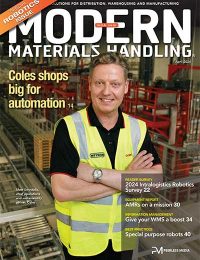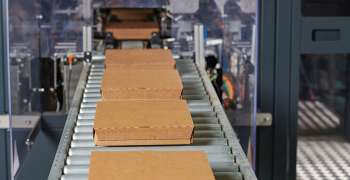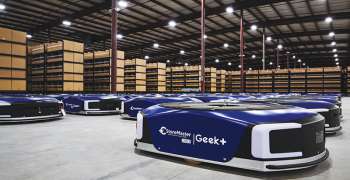Distribution success at Boscov’s
High-speed sortation and additional dock doors accommodate department store Boscov's growth strategy.
Latest Material Handling News
Registration open for Pack Expo International 2024 Walmart chooses Swisslog AS/RS and software for third milk processing facility NetLogistik partners with Vuzix subsidiary Moviynt to offer mobility solutions for warehouses Lucas Watson appointed CSO for Körber’s Parcel Logistics business in North America Hyster recognizes Dealers of Distinction for 2023 More NewsBoscov’s Department Store, LLC, Reading, Pa.
Size: 395,000 sq ft plus attached 85,000 sq ft building for stock replenishment
SKU’s: 8,000
Throughput: 200,000 cartons per week receiving/250,000 cartons per week shipping
Employees: 325
Shifts: 2 shifts, 5 days
Some stories are good enough to tell twice.
That’s the case with Boscov’s Department Stores, the largest independent department-store chain in the nation. Boscov’s, still family-owned today, with $1.2 billion in annual sales is headquartered in Reading, Pa.
MMH first visited Boscov’s 395,000 sq ft distribution center in 2004. Back then, Boscov’s faced a bottleneck in its distribution processes: Due to limitations in its materials handling processes, Boscov’s could receive almost twice as many cartons per hour as it could ship out. That not only slowed the delivery of product to the store, it required Boscov’s to devote valuable space to staging. That restricted the chain’s ability to grow its business without a significant investment in more warehouse space.
The solution: Instead of adding space, Boscov’s added automation, including a three-divert sliding shoe pre-sorter, the splitting of an existing pop-up shipping sorter into two units, and new scanning and control systems.
“On paper, the improvements may seem rather minor,” we wrote at the time. “But the dividends of the project have already been dramatic in just the first few months since its completion.” Those dividends included:
A nearly 10% reduction in distribution costs, and a 25% increase in throughput (200,000 cartons per week compared to 150,000) with no addition to headcount. But the biggest payoff may have been the capability to cross-dock the vast majority of product in record time. “Our shipments can be in receiving and out the door within 7 minutes,” the retailer told us at the time.
Fast-forward a few years, and Boscov’s found itself facing a bottleneck all over again. “Between 2003 and 2006, we grew the chain 25%, from 40 to 50 stores, including the acquisition of a number of stores from Macy’s,” says Bob Goonan, Boscov’s director of logistics. “We couldn’t add space to our existing distribution center and we didn’t want to build a new facility. So, we needed a way to maximize the flow of product within our existing facility.”
Working with a systems integrator (Blesco), Goonan and his team came up with a new design that will be implemented in two phases: The first, in place now, added additional sortation capabilities and eighteen dock doors to accommodate a total of 58 stores. The second phase, which will be implemented in the next few years, will handle an additional 20 stores, allowing the chain to grow to 78 stores.
Once again, the changes seem simple on paper, but, as with the previous makeover, they are already delivering big dividends:
Capacity increased by 25% with no addition to headcount.
Cost per unit dropped by 8%.
The units handled per hour increased by 12%.
Better yet, cross-docked cartons that once took 7 minutes to travel from the receiving dock to the shipping dock now make the journey in just six minutes.
“The bottleneck is gone,” says Goonan. “We can now have the capacity to ship out about 25% more cartons per day than we receive during peak periods.”
A growing chain
The Boscov’s story is one of growth driving change. For the first sixty years of its history, Boscov’s consisted of one store in Reading, Pa. In 1962, the company began its expansion program, building three more stores in the Reading area over the next six years.
Out of town expansion began in August 1972 with the opening of a store in Lebanon, Pa. By 2003, the chain had increased to 40 stores. By 2006, there were 50 stores in Boscov’s portfolio.
The chain has prospered as a regional player in an increasingly competitive retail environment by continuing to offer a full line of products – from major appliances and furniture to electronics, clothing and collectibles – by catering to the needs of its customers. “As a regional department store, we understand our customers,” says Goonan. “We rate very high on customer service.”
One key to maintaining those high customer service numbers is the ability to have the right merchandise in the store at the right times, especially around peak periods including the patio season, back-to-school and holidays. “As the supply chain has sped up, goods arrive at the distribution center much closer to the time when they’re needed in the store,” says Goonan.
With the chain continuing to grow, that became an issue. “We were taking product in our receiving area,” says Goonan. “But because there wasn’t a fluid movement of product, we spent more time and effort handling it. That was lowering our units handled per hour and raising our cost per unit.”
With more growth planned for the future, it was time to redesign the existing system again.
Building on success
To meet the demands of the new stores, the systems integrator designed a system that builds on the 2003 project, while allowing for future expansion.
“We decided to work within the existing four walls and to maximize the receiving sorter we installed in 2003,” says Goonan. “We also wanted the ability to handle 78 stores in the future in part by expanding to a second shift.”
The first step was to add twelve dock doors, bringing the total to 58 doors. The second step was to add a second sorter with seventeen diverts. Designed to process 135 cases per minute, the sorter manages inbound freight from five receiving doors and sorts outbound cartons to twelve doors. One of the five receiving lanes can also divert cartons to another sorter that manages processing to the other 46 store lanes. The original sorter is now used as a single divert to sort cartons to the new sorter.
There have been other changes as well.
ASN’s and compliance labeling: Boscov’s continues to increase the percentage of shipments with ASN’s and compliant labeling that enables cross-docking, from 65% of shipments in 2003 to 75% today.
Palletizing: While containerized freight comes into the facility floor-loaded, Boscov’s has aggressively worked to have more freight palletized. “With pallets, we can move a lot of product quickly to a processing table and onto the shipping sorter,” says Goonan.
Put it together, and the new system enables Boscov’s to keep its stores stocked with the inventory and products its customers have come to expect. “With these changes, we can now get product in the distribution center at 7 in the morning and have it on the floor of the stores the next day,” says Goonan. “Without them, I’m not sure we could compete.”
System Supplier
Warehouse control system and systems integration: Blesco, [url=http://www.blesco.com]http://www.blesco.com[/url]
Sliding shoe sortation and conveyor system: HK Systems/Dematic, [url=http://www.dematic.com]http://www.dematic.com[/url]
Extendable conveyors: Flexible Material Handling, [url=http://www.flexmh.com]http://www.flexmh.com[/url]
Fixed scanners: Accu-Sort Systems, [url=http://www.accusort.com]http://www.accusort.com[/url]
Handheld scanners: Motorola Solutions, [url=http://www.motorolasolutions.com/US-EN/Home]http://www.motorolasolutions.com/US-EN/Home[/url]
Label printers: Paxar, [url=http://www.paxar.com]http://www.paxar.com[/url]
Lift trucks: Clark Material Handling, [url=http://www.clarkmhc.com]http://www.clarkmhc.com[/url]
Order pickers: Crown, [url=http://www.crown.com]http://www.crown.com[/url]
This article previously appeared in the June 2008 issue of Modern Materials Handling

Article Topics
Latest in Materials Handling
Registration open for Pack Expo International 2024 Walmart chooses Swisslog AS/RS and software for third milk processing facility NetLogistik partners with Vuzix subsidiary Moviynt to offer mobility solutions for warehouses Materials Handling Robotics: The new world of heterogeneous robotic integration BSLBATT is looking for new distributors and resellers worldwide Lucas Watson appointed CSO for Körber’s Parcel Logistics business in North America Hyster recognizes Dealers of Distinction for 2023 More Materials HandlingAbout the Author
Subscribe to Materials Handling Magazine

Find out what the world's most innovative companies are doing to improve productivity in their plants and distribution centers.
Start your FREE subscription today.
April 2024 Modern Materials Handling

Latest Resources










